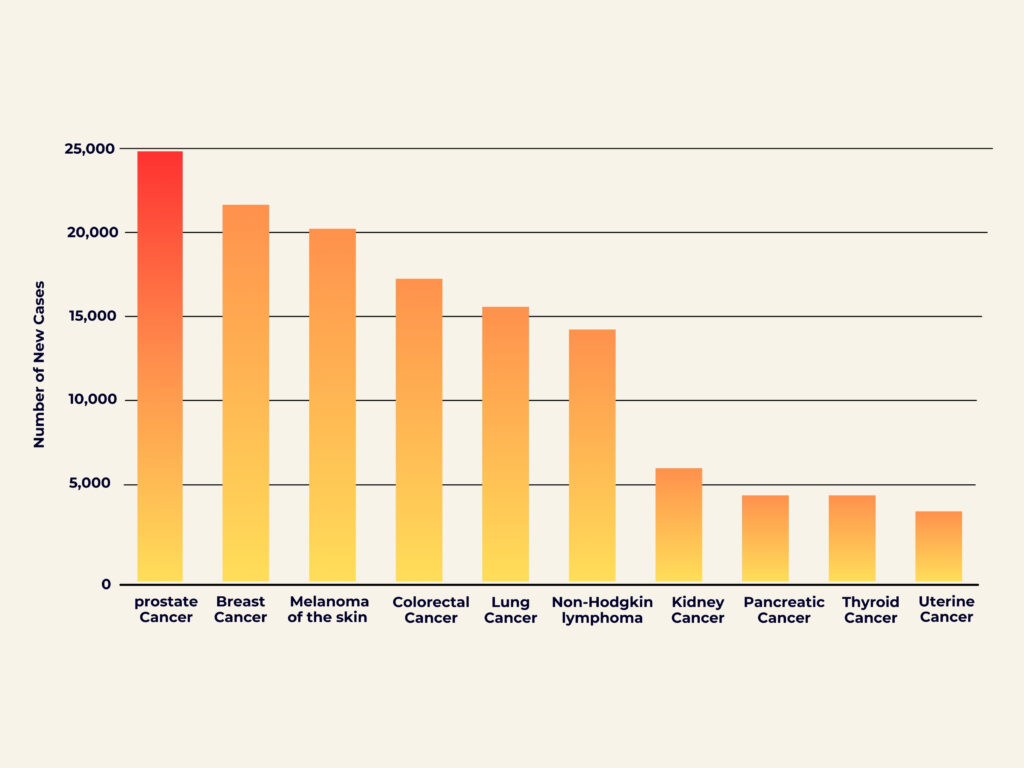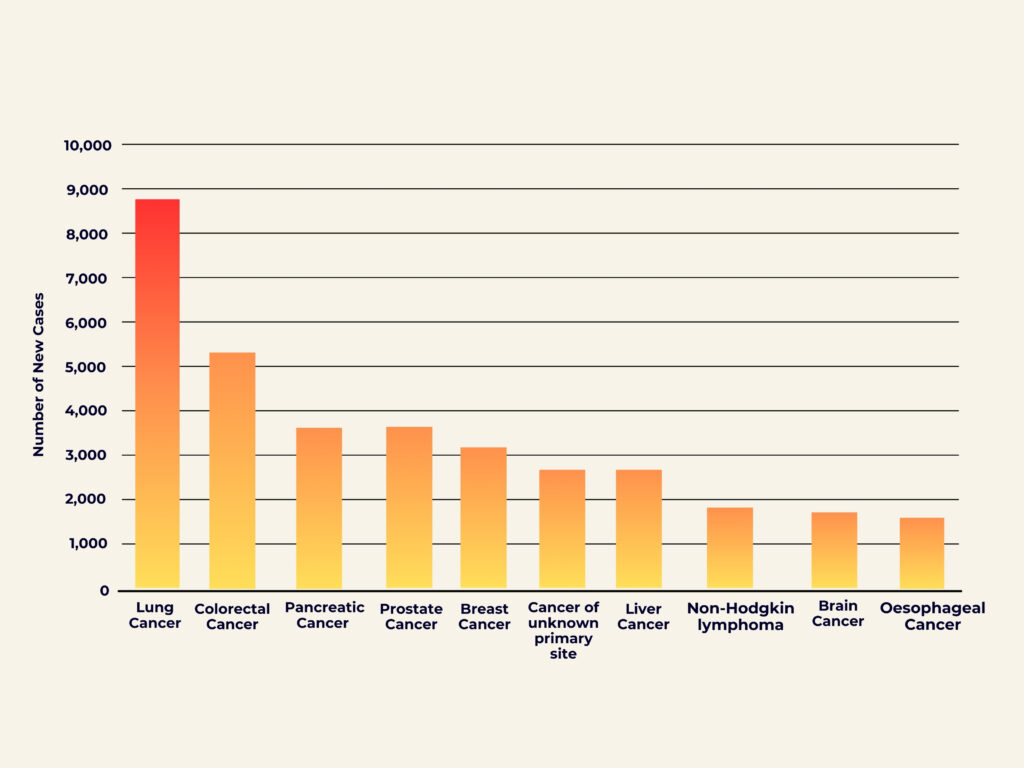Cancer ranks among the top health challenges facing Australians today. Not only in Men, there have been emerging alarming figures of cancer cases significantly in women since 2018 and afterward. According to research undertaken by the Australian Institute of Health and Welfare, 162,000 persons were diagnosed with cancer in 2022, with women accounting for 45 percent. Common types of cancer diagnosed in women include breast cancer, colorectal cancer, skin, and lung cancer. According to a recent estimate made by Cancer Council Australia in 2023 reveals that one in two women will be diagnosed with cancer by the age of 85 each upcoming year. How can Cancer be serious if it’s not managed properly?
Graph showing several cases diagnosed with different types of cancer in Australia in 2022

Below is the estimated mortality rate of cancer in Australia in 2022:

Cancer is a group of diseases in which body cells lead to abnormal and uncontrolled growth. Normally the growth of cells in the body occurs in a controlled manner in which new cells replace the old ones but genetic mutations disrupt this natural process and lead to a proliferation of uncontrolled cell division. This causes the formation of a mass of abnormal cells known as a tumor. These tumor cells start invading surrounding tissues and result in the further spread of tumors in other parts of the body like breast, ovaries, uterus, colon, rectum, and lungs in Women. Here we are going deep down to find out the common types and causes of cancer affecting women’s health and causing death.
- Breast Cancer
- Colorectal cancer
- Skin cancer
- Lung cancer
- Cervical cancer
- Endometrial cancer
- Ovarian cancer
Breast Cancer
Breast cancer is one of the most common types of cancer diagnosed in women impacting the surrounding breast cells, milk ducts, or milk-producing glands. According to estimates, it is the second most common type of cancer leading to death after lungs in Australia. Women may have breast cancer at any age but primarily those crossing their forties are at higher risk of carrying out this.
Causes and Prevention Strategies for Breast Cancer
Several factors may lead to breast cancer to occur but the most common Causes of Breast cancer are
- Inherited mutations in genes such as BRCA1 and BRCA2
- Hormonal imbalances, particularly elevated levels of estrogen
- Sedative lifestyle including alcohol consumption, obesity, and exposure to ionizing radiation
Early Screening with mammograms and ultrasounds is an effective defense for preventing Breast cancer and the proliferation of cancer cells. Maintaining a healthy diet and promoting breastfeeding are effective strategies against it.
Colorectal cancer
Cancer can even occur in some organs of the digestive system like the colon or rectum. Colorectal cancer begins slowly by showing noncancerous growths called polyps which may later on develop into deadly tumors.
Causes and Prevention Strategies
Some factors that can increase the risk of Colorectal cancer are
- Physical Inactivity
- Unhealthy Diet especially red meat
- Sedative lifestyle such as smoking and alcoholism
- Family History of colorectal cancer or polyps
Early detection through screening tests can stop the proliferation of Colorectal cancer. There are stool-based and Visual examination-based tests now available to prevent the formation of polyps.
Stool-based-based Tests are the Fecal immunochemical test FIT, and the Stool DNA test. Visual Examination includes Colonoscopy and CT colonography.
Here are prevention strategies to develop immunity against Colorectal cancer
- Healthy diet
- Regular physical activity
- Limit alcohol consumption
- Quit smoking
Skin cancer
Australian Fairy Skin is prone to attack Skin cancer which is why Australia is among the countries with the highest rate of Skin cancer. Women are at higher risk than men to catch Skin cancer.
According to an estimate made by Cancer Council Australia 2 out of 3 Australians will be diagnosed with Melanoma at the age of 70 or above.1,314 deaths were reported in Australia out of 18,257 cases.
Causes and Prevention
Here are some major causes that may lead to the development of Melanoma
- Exposure to UV radiation
- Sunburn
- Fairy Skin stimulates less Melanin Production
- Genetic Transmission
Mole Checks are an effective test to identify any suspicious moles or lesions that may indicate the presence of skin cancer at an early stage.
Several Prevention strategies may help you to carry out skin cancer
- Avoid excessive exposure to the sun, particularly between 10 a.m. and 4 p.m
- Use Sunscreen or Sun Protector while going outside
- Avoid tanning beds
- Avoid smoking
Lung cancer
Cancer may also develop in the cells lining the air passages in the lung tissue or the lung itself. It is one of the deadly cancers causing several deaths in Females. Non-small cell lung cancer (NSCLC) is the most common type of lung cancer that may develop into carcinoma. According to an estimate made by the Australian Government, In 2023 only 14,782 new cases of lung cancer were diagnosed in Australia including 7,086 in females. 1 in 40 females died of it at the age of 85 or above.
Causes and Prevention Strategies
Lung cancer disturbs or blocks the passage of air which is why a person may feel Shortness of breath, Persistent cough, and Chest pain.
Smoking including Passive smoking of Cigarettes and tobacco, exposure to carcinogens such as asbestos, arsenic, chromium, nickel, and smoking exhaust may accelerate the risk of lung cancer to develop. More exposure to radon gas and air pollution is another common cause of it. Here are prevention strategies that you must follow to prevent lung cancer
- Avoid Smoking and Tobacco
- Rooms should be airy and well-ventilated
- Avoid exposure to carcinogens and their reservoirs and handling places
Cervical Cancer
Cancer may develop in the Cervix which connects the uterus with the vagina. It is also the most common cause of death in women. It is curable if it is screened at the initial stage.
Cause and Prevention Strategies
Most common cause of Cervical Cancer is human papillomavirus (HPV). It is an infection that is transmitted by direct skin-to-skin contact such as sexual contact. Routes of transmission are vaginal, anal, and oral. During birth, it can be transmitted to the baby by the placenta. Smoking, Weak Immune Systems such as AIDs and not getting HPV shots are also cause of Cervical Cancer.
Although regular screening with Pap tests and HPV vaccination lowers the risk of Cervical Cancer to a great extent.
Here are the preventive ways to reduce the possibility of getting Cervical cancer
- Get Vaccinated with HPV Shots
- Regular Screening with Pap Test
- Safe Sex Practices
- Avoid Smoking
Endometrial Cancer
Female Reproductive systems can be affected by uncontrolled cell division. Endometrial cancer also known as uterine cancer may occur in the inner lining of the uterus that maintains the pregnancy. This is purely female cancer targeting women of age above 50 and may affect their reproductive health. Early detection through regular pelvic examination can be a defense against it.
Causes and Prevention
Here are several Underlying causes that may lead to Uterine cancer
- Excess level of estrogen relative to progesterone.
- Obesity and Diabetes
- Genetic Factors
These strategies may cut down the risk of getting Endometrial cancer
- Maintain a Healthy diet to control obesity
- Limit Hormone therapy
- Regular screening
Ovarian Cancer
Ovaries are female reproductive organs that produce eggs and hormones. Uncontrolled proliferation and division of cells in the ovary may result in the death of women because tumors may remain undetected in the ovary unless they are proliferated to the abdomen.
So No routine screening tests are effective against it.
Cause and Prevention
The following are the underlying causes of the proliferation of tumors in the ovary
- Women in the Family who have had breast cancer or Ovarian Cancer
- Genetic mutations in BRCA1 and BRCA2 genes
- Obesity
- Smoking
These ways can reduce the possibility of getting Ovarian cancer
- Take oral Contraceptive
- Breastfeeding and Pregnancy
- Stay healthy by eating a healthy diet
- Quit smoking
Conclusion
Prevention is better than cure. Early detection and routine Screening are crucial to prevent any type of cancer matter it is breast, colorectal, Skin, lung, or Endometrial. Several roots are common to lead them to all especially smoking, Tobacco, Alcoholism, and obesity.
Regular exercise and a Healthy diet with the proper amount of carbs, proteins, and low fats will keep healthy and active. Maintaining Hygiene is very important to destroy underlying microbes that increase the risk of developing cancer.


